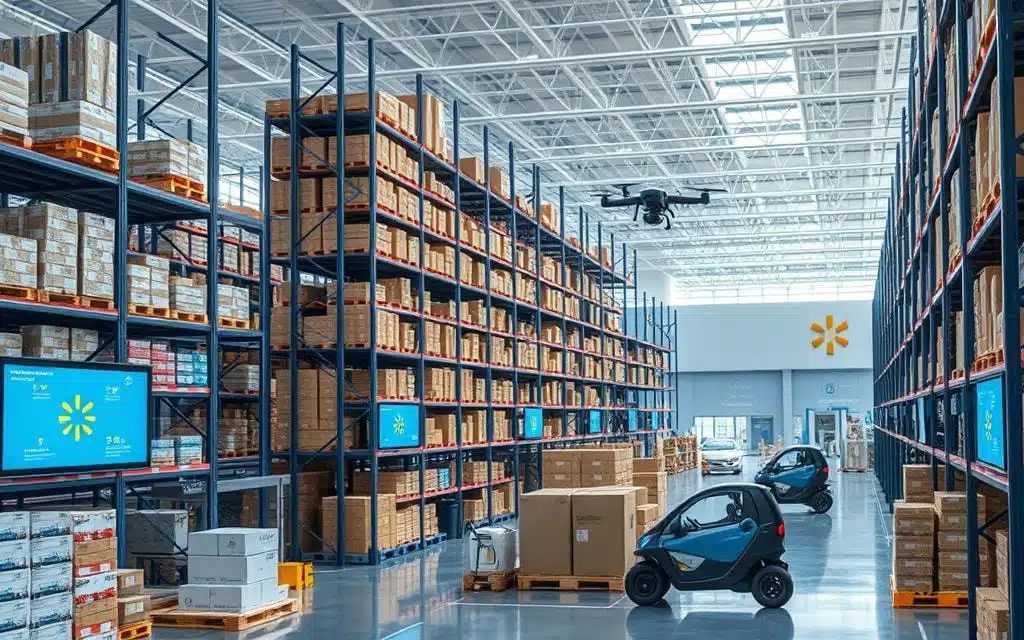Technology advances and consumer demands are changing rapidly at the helms of digital transformation in supply chain. The most successful supply chains embrace digital transformation. This powerful force reshapes logistics and manufacturing. Intelligent supply networks, smart manufacturing, and digital solutions help organizations grow and innovate.
Digital transformation in supply chain management boosts efficiency and growth. The global digital supply chain market is growing fast. It’s expected to reach $13,679 million by 2030. This shows the rising importance of digital technologies in today’s competitive world.

Leading companies use AI and machine learning to predict low stock. They optimize replenishment times and use blockchain for better customer engagement. IoT and GPS technologies enable real-time tracking. These advancements improve visibility and efficiency in supply chains.
Digital transformation also enables predictive analytics. This helps companies anticipate disruptions and make better decisions. It’s crucial for improving operations and driving sustainable growth.
Key Takeaways
- Digital transformation is a powerful force reshaping the landscape of logistics and manufacturing.
- The global digital supply chain market is expected to reach $13,679 million by 2030, reflecting the increasing importance of digital technologies.
- Leading companies are leveraging AI, machine learning, blockchain, IoT, and GPS technologies to revolutionize their supply chain operations.
- Digital transformation improves visibility, efficiency, and enables predictive analytics for better decision-making.
- Embracing digital transformation is crucial for companies seeking to enhance operational efficiency, improve agility, and drive sustainable growth.
Understanding Digital Transformation in Supply Chain
Digital supply chain transformation is changing how supply chains work. It uses new tech to make businesses run better. Companies can be more efficient and responsive by going digital.
Definition of Digital Transformation
Digital transformations mean using new tech in all parts of a business. It changes how companies work and help customers. For supply chains, it uses IoT, AI, and data tools.
These tools make processes smoother and decisions better. They also improve how the whole supply chain works.
The Impact of Technology on Supply Chains
Tech has a big effect on supply chains. Since 2018, AI startups got $50.5bn in funding. This is 33% of all supply chain tech funding.
This money is changing how sustainable logistics work. It helps companies use new tech and be more efficient.
Digital supply chains use current data for quick choices across the entire supply chain. Old supply chains use past data. IoT in supply chains gathers lots of data.
This helps businesses meet customer needs better. AI-driven logistics makes tasks automatic and more accurate. It helps manage many parts of the supply chain.
| Technology | Impact on Supply Chains |
|---|---|
| Internet of Things (IoT) | Enables real-time data collection and monitoring |
| Artificial Intelligence (AI) | Automates tasks, improves accuracy, and assists in decision-making |
| Data Analytics | Evaluates current and future trends, strengthens operations, and responds to disruptions |
Digital transformation is not just a buzzword; it is becoming a strategic imperative for many companies to drive efficiency, enhance transparency, and foster innovation within a rapidly evolving marketplace.
Digital change helps supply chains connect systems and people. This makes them react faster to changes in making or sending products.
Better teamwork through constant talking gives insights on stock, product availability, and shipping. This leads to happier customers.
The Role of Data Analytics in Supply Chains
Data analytics transforms supply chains in today’s fast-paced business world. Effective supply chain planning is crucial for optimizing processes and making informed decisions using data. Companies gain insights, optimize processes, and make informed decisions using data. Digital transformation empowers teams to collaborate, automate, and use analytics effectively.
This drives growth, reduces risk, and optimizes costs. Teams can work together seamlessly to improve supply chain performance.

Enhancing Decision-Making Processes
Data analytics helps organizations make smart choices, boosting supply chain efficiency. Martyna Jones, a Data Analytics Manager at M&S, improved supply chain management.
She reduced product replenishment frequency, increasing efficiency. Analyzing past data, current trends, and future projections helps companies spot areas for improvement.
| Benefits of Data Analytics | Impact on Supply Chain |
|---|---|
| Improved Decision-Making | Data-driven insights for optimized processes |
| Increased Efficiency | Streamlined operations and reduced costs |
| Enhanced Customer Loyalty | 88% of consumers show greater loyalty to socially responsible companies |
Predictive Analytics for Demand Forecasting
Predictive analytics for supply chain management is a game-changer. It helps companies forecast demand, optimize inventory, and reduce waste. BASF uses AI to predict stock levels and replenishment times.
This increases inventory visibility and enables smarter planning. Predictive analytics can also forecast disruptions like supplier issues, transportation delays, and natural disasters.
“Nearly 70% of companies surveyed accelerated their digital road maps during the pandemic, as revealed by a late 2020 Gartner survey.”
Cloud-based supply chain management solutions are gaining popularity. Gartner’s 2021 survey shows 43% of enterprises plan to digitalize and integrate innovative technology.
Cloud platforms offer real-time visibility, collaboration, and agility. This helps companies respond quickly to changes in demand and supply.
Key Technologies Driving Transformation
Cutting-edge technologies are revolutionizing supply chain transformation. These innovations optimize processes, enhance visibility, and drive data-driven decisions. As a result, businesses are seeing increased efficiency and profitability.
Internet of Things (IoT)
Internet of Things (IoT) is crucial in digitally transforming supply chains. It connects devices and enables real-time data monitoring. This gives businesses unprecedented visibility into their operations.
IoT sensors and GPS tracking systems monitor shipment locations and inventory status. Companies can respond quickly to delays and optimize their supply chain performance.
The impact of IoT on supply chains is significant. Here are some key statistics:
-
Nearly all companies have experienced a cybersecurity breach within their supply chain, highlighting the importance of secure IoT implementations.
-
Predictive analytics, enabled by IoT data, allow businesses to reduce inventory costs and improve service levels.
-
Automation in supply chain operations, driven by IoT connectivity, leads to substantial cost savings and improves delivery times.
Artificial Intelligence (AI) & Machine Learning
AI and Machine Learning (ML) are transforming supply chain management. They help businesses use vast amounts of data for optimization and decision-making. AI systems analyze complex datasets, identify patterns, and provide valuable insights.
ML algorithms continuously learn and adapt. This allows supply chain processes to become more intelligent and efficient over time. The results are remarkable:
| Technology | Impact |
|---|---|
| AI-powered predictive maintenance | Reduces unplanned downtime by up to 50% |
| ML-based demand forecasting | Improves forecast accuracy by 30-50% |
| AI-driven quality control | Detects defects with 90%+ accuracy |
Blockchain in supply chain management is another transformative technology. It creates a secure, transparent ledger of transactions. This reduces fraud and errors while boosting trust among partners.

Digital twin technology is also revolutionizing supply chains. Companies like Siemens use it to create virtual replicas of assets or processes. This allows them to simulate and optimize operations before making real-world changes.
The digital transformation of supply chains is not just about adopting new technologies; it’s about leveraging these innovations to drive meaningful change and create value for businesses and their customers.
Organizations are embracing IoT, AI, ML, blockchain, and digital twin technology. This shift is creating more agile, resilient, and competitive supply chains. The future of supply chain management is digital, and data driven.
Benefits of Digital Transformation in Supply Chains
Digital transformation in supply chains boosts efficiency and customer satisfaction. Companies that have successfully implemented digital transformation see significant improvements in efficiency and customer satisfaction. It uses advanced tech and data insights to optimize processes. This helps cut costs and improve competitiveness.
Increased Efficiency & Productivity
Digital supply chains dramatically boost efficiency and productivity. An MIT report shows it can cut process costs by 50% and increase revenue by 20%.
Real-time data enables faster, smarter decisions. This transparency helps identify and fix bottlenecks quickly. It improves overall supply chain efficiency.
Automation reduces errors and speeds up processes. This frees up resources for strategic activities that drive value.
Improved Customer Satisfaction
Digital supply chains boost customer satisfaction. They offer real-time tracking, fast order processing, and smooth communication.
Advanced analytics provide insights into customer behavior and demand patterns. This helps optimize inventory and ensure product availability.

Companies can adapt quickly to changing demands. This increases agility and improves customer engagement.
“Nearly 70% of digital transformation programs fail to achieve their primary objectives due to employees lacking the skills required to work with new systems.” – McKinsey & Company
To succeed, companies must invest in training their workforce. Employees need skills to use new tech effectively.
Creating a culture of learning is key. Proper support ensures a successful digital transformation journey.
Overcoming Challenges in Digital Transformation
Companies face hurdles in their digital transformation journeys. Supply chain leaders play a crucial role in overcoming these challenges and guiding transformation efforts. Resistance to change and legacy system integration are two major obstacles. A strategic approach and change management focus can help overcome these challenges.
Resistance to Change
Employees and executives often resist digital transformation. This resistance stems from fear and job security concerns. Studies show 70% of digital programs fail due to such resistance.
Organizations must prioritize change management to succeed. A comprehensive plan increases success chances six-fold. Transparent communication, employee involvement, and training are key components.
Integration with Legacy Systems
Integrating new tech with legacy systems is challenging. Many organizations have invested heavily in older systems. These systems can be slow and inflexible, hindering progress.
An IBM study found 60% of CIOs and CTOs feel unprepared for future IT needs. Companies must assess existing systems and plan strategically for integration.
Options include phasing out old systems or implementing middleware solutions. IT and business teams must collaborate to align integration with business goals.
Success requires addressing skill gaps and ensuring data privacy and security. Companies should align programs with business outcomes. Fostering change, maintaining communication, and developing solid plans are crucial.

Case Studies of Successful Transformations
Digital transformation is key to business success today. These companies have transformed their entire supply chain ecosystem to achieve remarkable results. It gives companies an edge, boosts efficiency, and improves customer satisfaction. Let’s look at some inspiring examples of digital transformation leaders.
Leading Companies Embracing Digital Change
Walmart has transformed its supply chain using digital tech. They use IoT and GPS for real-time tracking, improving transparency and efficiency. This led to a 50% boost in online sales and 5% cut in costs.
Farmer Connect uses blockchain to link coffee growers and consumers. Their “Thank My Farmer” app lets users trace their coffee’s origin. This has improved farmers’ lives and boosted consumer trust.
Lessons Learned from Industry Leaders
Data analytics is crucial for smart decisions. Walmart used it to increase online holiday sales by 40% in 2019. Cross-functional teamwork and change management are also vital.
Companies that focus on digital leadership and innovation perform better. They’re 1.5 times more likely to be top financial performers in their industry.
| Company | Digital Transformation Initiative | Impact |
|---|---|---|
| Walmart | Supply Chain Optimization | 50% increase in online sales, 5% reduction in operational costs |
| Starbucks | Mobile App and Loyalty Program | 1% increase in customer visit frequency, 9% growth in revenue |
| Domino’s Pizza | Digital Ordering and Delivery | 33% increase in quarterly revenue |
The numbers are clear. Digital-savvy companies are 26% more profitable than their peers. Also, 94% with a clear strategy meet their goals.

Digital transformation will keep shaping business. By learning from leaders and embracing change, companies can innovate and compete better. The digital era offers new opportunities for those ready to adapt.
The Future of Supply Chains with Digital Transformation
Digital innovations are reshaping supply chains. AI-powered forecasting and blockchain-secured transactions are evolving logistics. Green tech startups and sustainable logistics drive efficiency and innovation in supply chain management.
Smart warehouses are a key trend to watch. They use IoT devices, robotics, and AI to optimize operations. An e-commerce giant has integrated robots for faster order fulfillment.
Digital dashboards offer real-time tracking of goods. This enhances decision-making, reduces delays, and improves customer satisfaction.
Trends to Watch
80% of businesses adopt digital transformation in supply chains. This is driven by customer demands for faster, more transparent deliveries. Companies using digital tools gain a competitive edge.
They increase efficiency, lower costs, and improve customer service. Notable trends include:
-
AI and machine learning algorithms for sales trend forecasting, demand prediction, and risk mitigation
-
Big data analytics to enhance fuel consumption, improve delivery times, and optimize routes
-
Blockchain technology for tracing ingredient origins, ensuring food safety, and enabling product authenticity verification
Anticipating Changes in Consumer Behavior
Digital transformation helps companies adapt to changing consumer behavior. Customers now prioritize sustainability and transparency. Green tech startups and sustainable logistics practices are gaining popularity.
Digital tools help monitor environmental impact. They optimize routes to reduce waste. Companies can provide detailed information about product origins and carbon footprints.
The future of supply chains is digital. Technology drives efficiency, agility, and innovation. Businesses embracing this change will thrive in the evolving marketplace.

The Importance of Collaboration & Communication
Effective collaboration and communication are crucial for successful supply chain operations. Technology advances and disruptions have made stakeholder collaboration and supply chain transparency essential. These factors help navigate challenges and drive innovation.
A recent survey shows engineers spend more time on supply chain work. In 2023, 52% spent at least six hours weekly, up 73% from last year. This trend highlights the growing need for cross-functional collaboration in supply chains.
Open communication and digital tools can improve decision-making and efficiency. These elements also enhance proactive problem-solving throughout the supply chain.
Cross-Functional Teams
Cross-functional teams are vital for digital transformation in supply chains. These teams should include IT, supply chain management, data management, and project management experts. Diverse perspectives help develop comprehensive strategies for unique supply chain challenges.
The Hackett Group’s 2024 study stresses the need for agility in procurement. Cross-functional collaboration helps organizations adapt quickly to market changes and customer demands. This approach ensures a more resilient and responsive supply chain.
Maintaining Transparency with Stakeholders
Transparency builds trust and fosters long-term relationships with supply chain stakeholders. Sharing information and maintaining open communication enhances collaboration and reduces risks. The Hackett Group’s report emphasizes supplier relationship management for driving innovation and optimization.
Digital platforms like ShareAspace Design to Manufacturing offer structured product data sharing solutions. These tools enable informed decision-making and supplier performance monitoring. Companies can unlock the full potential of supply chain collaboration with these platforms.
| Collaboration Strategy | On-Time Delivery Rate |
|---|---|
| Excellent | 95%+ |
| Less Effective | 75-80% |
Companies with active supply chain collaboration face 20% fewer disruptions. Organizations using robust risk management strategies experience 20% fewer supply chain disruptions. These findings highlight the importance of collaboration and transparency in supply chains.
Manufacturers are rethinking supply chain operations due to recent disruptions. Prioritizing collaboration and communication are key to success. Embracing digital transformation and fostering transparency helps build stronger, more resilient supply chains.
Training and Upskilling for Digital Transformation
Digital transformation is changing supply chains. Supply chain managers need to be equipped with the latest skills and knowledge to leverage new technologies effectively. Organizations need a skilled workforce for new technologies and processes. The World Economic Forum predicts job losses and new roles by 2025.
Companies should focus on three key areas: digital skills, soft skills, and technical skills. This will help navigate the workforce transition.
Role-based training helps employees focus on necessary skills. Data analysis is crucial for faster, fact-based decision-making. Training should be ongoing and address specific skill gaps.
Companies can benefit by rewarding employees for completing training. Using new technology during initial phases is also important.
Building a Skilled Workforce
New roles in supply chain include strategic relationship managers and risk management advisors. Sustainability officers and digital transformation leaders are also emerging.
Supply chain professionals are now strategic partners to various departments. Strong supplier relationships helped organizations face fewer challenges during the pandemic.
Continuous Learning in Supply Chains
Upskilling can happen through online platforms, workshops, and mentorship programs. Collaborating with universities is another way to improve employee skills.
By 2030, automation may force millions to switch jobs or learn new skills. Ongoing learning is crucial in today’s job market.
External partners can help develop strategies for digital transformation and training. Organizations must prioritize supply chain talent development for success in the digital age.
Measuring Success in Digital Transformation
Clear metrics and KPIs are vital for digital transformation in supply chains. Tracking the right supply chain performance metrics helps evaluate digital initiatives’ effectiveness. It enables data-driven decisions for continuous improvement.
Digital transformation aims to boost operational efficiency in supply chains. Key metrics include process cycle times, automation rates, and resource utilization. These helps identify bottlenecks and streamline processes.
Analyzing these metrics optimizes resource allocation. It leads to improved efficiency and reduced costs in supply chain operations.
Key Performance Indicators (KPIs)
Here are essential KPIs for measuring digital transformation success in supply chains:
| KPI | Description |
|---|---|
| Customer Satisfaction | Monitor customer satisfaction scores, digital engagement levels, and user interaction data to assess the impact on customer experience. |
| Employee Productivity | Track employee performance metrics such as task completion rates, project delivery timelines, and digital skills advancement to evaluate productivity improvements. |
| Inventory Management | Assess inventory levels, turnover rates, and optimization efforts to reduce costs and improve efficiency. |
| Supply Chain Efficiency | Evaluate metrics related to lead times, supplier relationships, and cost reduction to identify areas for improvement in the digital transformation process. |
Evaluating ROI on Digital Investments
Measuring digital transformation ROI justifies investments in digital initiatives. Both tangible and intangible benefits should be considered. Tangible benefits include cost savings and increased revenue.
Intangible benefits encompass enhanced customer satisfaction and employee engagement. Innovation is another crucial intangible benefit to consider.
By aligning digital transformation metrics with overall business objectives, organizations can ensure that the measured success is in line with broader strategic goals in supply chain management.
Digital analytics tools and business intelligence platforms are crucial for measuring success. Custom dashboards integrated with content platforms provide valuable insights. These tools enable data-driven decision-making in supply chain digital transformation.
Conclusion: Embracing Change for a Better Future
Digital transformation in supply chain management drives innovation, efficiency, and competitiveness. Organizations can unlock new opportunities by adopting cutting-edge technologies. This approach ensures growth and success in the ever-evolving business landscape.
The Path Forward for Supply Chains
Companies must invest in the latest technologies to optimize their operations. Warehouse automation, predictive analytics, and IoT are key areas for improvement.
Studies show that 50% of companies plan to invest in supply chain innovation by 2025. Their focus is on autonomous vehicles, machine learning, and 3D printing.
Organizations should carefully consider the risks and benefits of these investments. This approach helps avoid wasting resources on outdated solutions and ensures long-term success.
Final Thoughts on Digital Transformation
Digital transformation will continue to shape the supply chain landscape. Organizations can achieve new levels of efficiency, agility, and resilience by embracing change.
Advanced analytics tools, collaborative platforms, and demand-supply alignment strategies offer endless growth opportunities. Companies must remain open to change and invest in their digital transformation strategy.
Continuously seeking new ways to drive value is essential for success in the supply chain. This proactive approach will help organizations thrive in the digital age.
FAQ
What is digital transformation in supply chain management?
Digital transformation in supply chains uses advanced tech to boost efficiency and decision-making. It leverages IoT, AI, machine learning, and blockchain across the entire network. This enables real-time analysis, predictive analytics, and process automation.
How does digital transformation differ from traditional supply chain management?
Digital supply chains use real-time data for instant decisions. Traditional ones rely on historical data. Digital systems integrate IT and operational tech to predict issues. In digital chains, machines drive decisions with human oversight.
What are the key technologies driving digital transformation in supply chains?
Key tech includes IoT, AI, machine learning, blockchain, cloud computing, and digital twin. These enable real-time data collection and analysis. They also improve transparency and collaboration among supply chain partners.
What are the benefits of implementing digital transformation in supply chains?
Digital transformation boosts efficiency, customer satisfaction, visibility, and risk management. It also optimizes costs. Teams can collaborate better, automate processes, and make data-driven decisions.
What challenges do organizations face when implementing digital transformation in their supply chains?
Challenges include resistance to change, lack of digital skills, and data security concerns. High implementation costs can also be an issue. Overcoming these requires effective change management and employee training.
How can organizations measure the success of their digital transformation initiatives in supply chains?
Success is measured by tracking KPIs like inventory turnover and order fulfillment rate. Regular audits and process optimization are crucial. Organizations should evaluate ROI based on financial outcomes.
What role does collaboration play in the success of digital transformation in supply chains?
Collaboration is key for successful digital transformation. It requires cross-functional leadership beyond just the supply chain. IT and supply chain teams should lead, supported by data and project management.
How can organizations prepare their workforce for digital transformation in supply chains?
Organizations must build a skilled workforce to leverage new tech. This involves training, hiring skilled staff, and partnering with tech providers. Continuous learning is essential to stay updated with the latest trends.
What does the future hold for digital transformation in supply chains?
The future involves more advanced tech adoption and trends like green tech. Organizations must anticipate changes in consumer behavior. Success depends on embracing change and developing strong digital strategies.







1 thought on “Why Is Digital Transformation in Supply Chain So Powerful?”
Comments are closed.